Citibank 2015 Annual Report Download - page 270
Download and view the complete annual report
Please find page 270 of the 2015 Citibank annual report below. You can navigate through the pages in the report by either clicking on the pages listed below, or by using the keyword search tool below to find specific information within the annual report.-
 1
1 -
 2
2 -
 3
3 -
 4
4 -
 5
5 -
 6
6 -
 7
7 -
 8
8 -
 9
9 -
 10
10 -
 11
11 -
 12
12 -
 13
13 -
 14
14 -
 15
15 -
 16
16 -
 17
17 -
 18
18 -
 19
19 -
 20
20 -
 21
21 -
 22
22 -
 23
23 -
 24
24 -
 25
25 -
 26
26 -
 27
27 -
 28
28 -
 29
29 -
 30
30 -
 31
31 -
 32
32 -
 33
33 -
 34
34 -
 35
35 -
 36
36 -
 37
37 -
 38
38 -
 39
39 -
 40
40 -
 41
41 -
 42
42 -
 43
43 -
 44
44 -
 45
45 -
 46
46 -
 47
47 -
 48
48 -
 49
49 -
 50
50 -
 51
51 -
 52
52 -
 53
53 -
 54
54 -
 55
55 -
 56
56 -
 57
57 -
 58
58 -
 59
59 -
 60
60 -
 61
61 -
 62
62 -
 63
63 -
 64
64 -
 65
65 -
 66
66 -
 67
67 -
 68
68 -
 69
69 -
 70
70 -
 71
71 -
 72
72 -
 73
73 -
 74
74 -
 75
75 -
 76
76 -
 77
77 -
 78
78 -
 79
79 -
 80
80 -
 81
81 -
 82
82 -
 83
83 -
 84
84 -
 85
85 -
 86
86 -
 87
87 -
 88
88 -
 89
89 -
 90
90 -
 91
91 -
 92
92 -
 93
93 -
 94
94 -
 95
95 -
 96
96 -
 97
97 -
 98
98 -
 99
99 -
 100
100 -
 101
101 -
 102
102 -
 103
103 -
 104
104 -
 105
105 -
 106
106 -
 107
107 -
 108
108 -
 109
109 -
 110
110 -
 111
111 -
 112
112 -
 113
113 -
 114
114 -
 115
115 -
 116
116 -
 117
117 -
 118
118 -
 119
119 -
 120
120 -
 121
121 -
 122
122 -
 123
123 -
 124
124 -
 125
125 -
 126
126 -
 127
127 -
 128
128 -
 129
129 -
 130
130 -
 131
131 -
 132
132 -
 133
133 -
 134
134 -
 135
135 -
 136
136 -
 137
137 -
 138
138 -
 139
139 -
 140
140 -
 141
141 -
 142
142 -
 143
143 -
 144
144 -
 145
145 -
 146
146 -
 147
147 -
 148
148 -
 149
149 -
 150
150 -
 151
151 -
 152
152 -
 153
153 -
 154
154 -
 155
155 -
 156
156 -
 157
157 -
 158
158 -
 159
159 -
 160
160 -
 161
161 -
 162
162 -
 163
163 -
 164
164 -
 165
165 -
 166
166 -
 167
167 -
 168
168 -
 169
169 -
 170
170 -
 171
171 -
 172
172 -
 173
173 -
 174
174 -
 175
175 -
 176
176 -
 177
177 -
 178
178 -
 179
179 -
 180
180 -
 181
181 -
 182
182 -
 183
183 -
 184
184 -
 185
185 -
 186
186 -
 187
187 -
 188
188 -
 189
189 -
 190
190 -
 191
191 -
 192
192 -
 193
193 -
 194
194 -
 195
195 -
 196
196 -
 197
197 -
 198
198 -
 199
199 -
 200
200 -
 201
201 -
 202
202 -
 203
203 -
 204
204 -
 205
205 -
 206
206 -
 207
207 -
 208
208 -
 209
209 -
 210
210 -
 211
211 -
 212
212 -
 213
213 -
 214
214 -
 215
215 -
 216
216 -
 217
217 -
 218
218 -
 219
219 -
 220
220 -
 221
221 -
 222
222 -
 223
223 -
 224
224 -
 225
225 -
 226
226 -
 227
227 -
 228
228 -
 229
229 -
 230
230 -
 231
231 -
 232
232 -
 233
233 -
 234
234 -
 235
235 -
 236
236 -
 237
237 -
 238
238 -
 239
239 -
 240
240 -
 241
241 -
 242
242 -
 243
243 -
 244
244 -
 245
245 -
 246
246 -
 247
247 -
 248
248 -
 249
249 -
 250
250 -
 251
251 -
 252
252 -
 253
253 -
 254
254 -
 255
255 -
 256
256 -
 257
257 -
 258
258 -
 259
259 -
 260
260 -
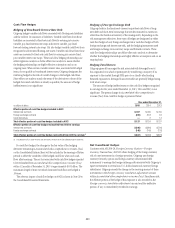 261
261 -
 262
262 -
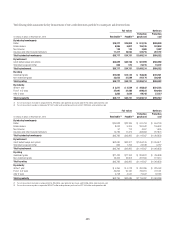 263
263 -
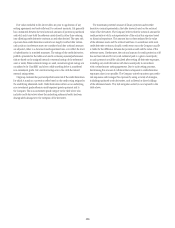 264
264 -
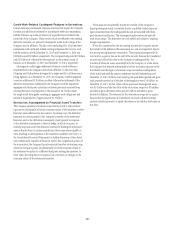 265
265 -
 266
266 -
 267
267 -
 268
268 -
 269
269 -
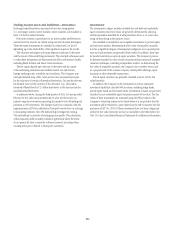 270
270 -
 271
271 -
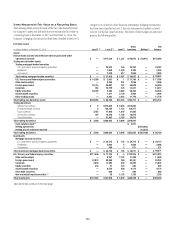 272
272 -
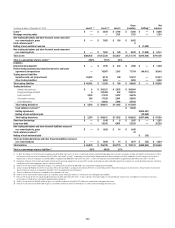 273
273 -
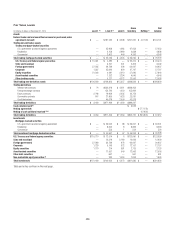 274
274 -
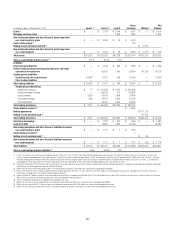 275
275 -
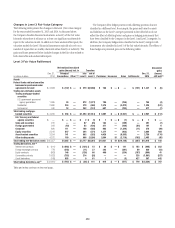 276
276 -
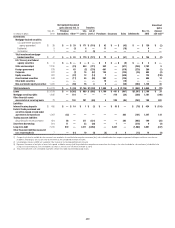 277
277 -
 278
278 -
 279
279 -
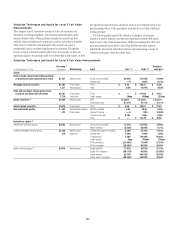 280
280 -
 281
281 -
 282
282 -
 283
283 -
 284
284 -
 285
285 -
 286
286 -
 287
287 -
 288
288 -
 289
289 -
 290
290 -
 291
291 -
 292
292 -
 293
293 -
 294
294 -
 295
295 -
 296
296 -
 297
297 -
 298
298 -
 299
299 -
 300
300 -
 301
301 -
 302
302 -
 303
303 -
 304
304 -
 305
305 -
 306
306 -
 307
307 -
 308
308 -
 309
309 -
 310
310 -
 311
311 -
 312
312 -
 313
313 -
 314
314 -
 315
315 -
 316
316 -
 317
317 -
 318
318 -
 319
319 -
 320
320 -
 321
321 -
 322
322 -
 323
323 -
 324
324 -
 325
325 -
 326
326 -
 327
327 -
 328
328 -
 329
329 -
 330
330 -
 331
331 -
 332
332
 |
 |
252
Trading Account Assets and Liabilities—Derivatives
Exchange-traded derivatives, measured at fair value using quoted
(i.e., exchange) prices in active markets, where available, are classified as
Level 1 of the fair value hierarchy.
Derivatives without a quoted price in an active market and derivatives
executed over the counter are valued using internal valuation techniques.
These derivative instruments are classified as either Level 2 or Level 3
depending upon the observability of the significant inputs to the model.
The valuation techniques and inputs depend on the type of derivative
and the nature of the underlying instrument. The principal techniques used
to value these instruments are discounted cash flows and internal models,
including Black-Scholes and Monte Carlo simulation.
The key inputs depend upon the type of derivative and the nature
of the underlying instrument and include interest rate yield curves,
foreign-exchange rates, volatilities and correlation. The Company uses
overnight indexed swap (OIS) curves as fair value measurement inputs
for the valuation of certain collateralized derivatives. Citi uses the relevant
benchmark curve for the currency of the derivative (e.g., the London
Interbank Offered Rate for U.S. dollar derivatives) as the discount rate for
uncollateralized derivatives.
As referenced above, during the third quarter of 2014, Citi incorporated
FVA into the fair value measurements due to what it believes to be an
industry migration toward incorporating the market’s view of funding risk
premium in OTC derivatives. The charge incurred in connection with the
implementation of FVA was reflected in Principal transactions as a change
in accounting estimate. Citi’s FVA methodology leverages the existing
CVA methodology to estimate a funding exposure profile. The calculation
of this exposure profile considers collateral agreements where the terms
do not permit the firm to reuse the collateral received, including where
counterparties post collateral to third-party custodians.
Investments
The investments category includes available-for-sale debt and marketable
equity securities whose fair values are generally determined by utilizing
similar procedures described for trading securities above or, in some cases,
using vendor pricing as the primary source.
Also included in investments are nonpublic investments in private equity
and real estate entities. Determining the fair value of nonpublic securities
involves a significant degree of management judgment, as no quoted prices
exist and such securities are generally thinly traded. In addition, there may
be transfer restrictions on private equity securities. The Company’s process
for determining the fair value of such securities utilizes commonly accepted
valuation techniques, including comparables analysis. In determining the
fair value of nonpublic securities, the Company also considers events such
as a proposed sale of the investee company, initial public offerings, equity
issuances or other observable transactions.
Private equity securities are generally classified as Level 3 of the fair
value hierarchy.
In addition, the Company holds investments in certain alternative
investment funds that calculate NAV per share, including hedge funds,
private equity funds and real estate funds. Investments in funds are generally
classified as non-marketable equity securities carried at fair value. The fair
values of these investments are estimated using the NAV per share of the
Company’s ownership interest in the funds where it is not probable that the
investment will be realized at a price other than the NAV. Consistent with the
provisions of ASU No. 2015-07 these investments have not been categorized
within the fair value hierarchy and are not included in the tables below. See
Note 13 to the Consolidated Financial Statements for additional information.
